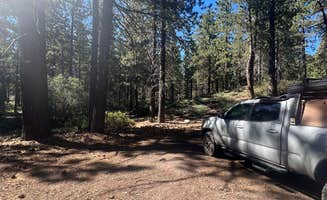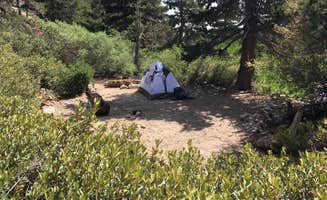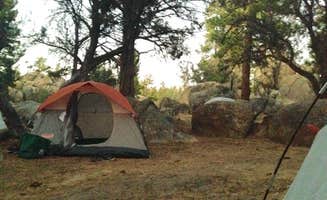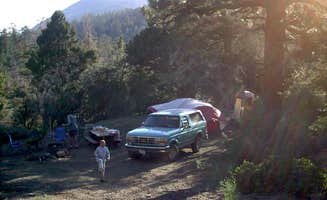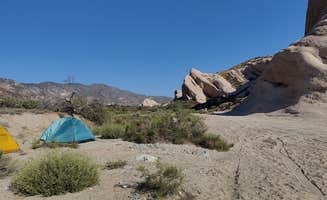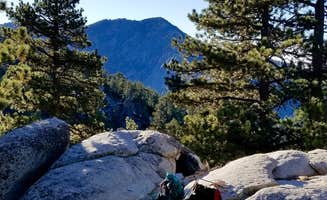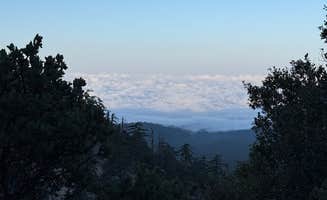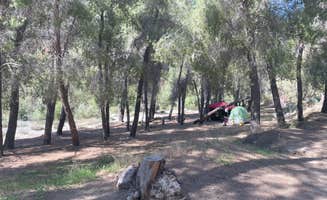Dispersed camping near Redlands, California offers backcountry sites ranging from 2,000 to 11,500 feet in elevation across the San Bernardino National Forest. Most camping zones require visitors to practice Leave No Trace principles, with seasonal restrictions that vary by specific location and elevation. Fall camping conditions typically feature daytime temperatures between 60-75°F with nighttime lows dropping to 40°F at higher elevations.
What to do
Hiking to summit camps: High Creek Camp provides a challenging but rewarding base for San Gorgonio summit attempts, with camping spots along a creek. "The sound of the water is the best part of this campground in my eyes. As well as it is a great place to stay as a overnight to break up a summit trip," reports one camper at High Creek Camp.
Rock climbing opportunities: Holcomb Valley area near Big Bear offers dispersed camping specifically popular with climbers. "It is a free campground, first come first serve. There are no developed facilities (i.e., no firepits, outhouses, etc.) but it is beautiful and there are plenty of flat places to set up a tent. This area is used almost exclusively by rock climbers, but anyone is welcomed," notes a visitor at Holcomb Valley Climbers Camp.
Gold panning: Historical sites in Holcomb Valley provide opportunities to try gold panning in active claim areas. "If you're into panning for gold you just might find some along Holcomb Creek. There are active claims in the area so be respectful," advises an experienced camper.
What campers like
Privacy at higher elevations: Remote yellow post sites offer solitude away from more crowded areas. "You will earn this spot as the drive from Hwy 38 is long and rocky. The final road to the spot is a single lane and others wanting to camp there will not know if it is occupied so you may get to meet so new friends. It is up on the ridge some lots of solitude and views," shares a camper about Yellow Post #54.
Wildlife viewing: Multiple dispersed camping areas offer chances to see deer and other forest wildlife. "Starlink internet here was great and we stayed 2 days to work here. Saw multiple deer walking by our site," reports a visitor at East Flats.
Cell service availability: Many free camping areas maintain surprisingly good connectivity despite their remote locations. "Great free camping when campgrounds are booked. Easy to navigate with GPS. Many large and small sites along the road. Some spots more secluded than others. Good cellular reception in my particular location," notes a camper at Mill Creek Dispersed Camping.
What you should know
Road conditions vary significantly: Access roads can range from passenger car accessible to high-clearance only. "My wife and I were looking for good boondocking spots yesterday and we decided to check out this spot, after finding it on The Dyrt and a few other sites. It's definitely a beautiful place, and most of the road to the site is paved, but the road up to the actual spot is gravel, with lots of potholes and washboard areas," warns a visitor about Mill Creek.
Fire permit requirements: Many free camping areas require fire permits that can be obtained online from the San Bernardino National Forest. "You will need a campfire permit to have a fire when permitted, you can get them online from San Berdoo Forest," advises a camper at Coon Creek Yellow Post.
Wilderness permits needed: Summit camping and backcountry sites in the San Gorgonio Wilderness require advance permits. "This camp is just as it states. Summit camp. The summit of San Gorgonio! The tallest mountain in Southern California. This camp is very minimal; it sits just under 11,501 ft," notes a San Gorgonio Summit camper.
Tips for camping with families
Choose accessible sites: Some dispersed areas offer family-friendly terrain with room for exploration. "The road up to the camp area is a bit rough. We were in a Sprinter and definitely nervous for parts. But, it was worth it once we got there! It's secluded and has enough trees for a hammock. Our kids loved being able to explore, but they were covered in sand/dirt by the end of the trip," shares a visitor to Holcomb Valley.
Bring all water needed: No potable water exists at most dispersed sites, requiring families to pack in all drinking water. "No amenities but still nice and the price is right!" notes a camper at Bear Lake.
Prepare for dust: Many sites feature sandy or dusty ground that can be challenging with children. "It's secluded and has enough trees for a hammock. Our kids loved being able to explore, but they were covered in sand/dirt by the end of the trip," adds a family camper.
Tips from RVers
Scout before committing: Many dispersed areas have limited turnaround space for larger rigs. "The first spots on the left are big rig friendly, you do have about a mile of dirt road before you get to them. Many spots that fill on the weekend quickly, road gets rougher the more you continue up to the cabin, if you have a bigger trailer and don't find any spots in the first few locations turn around," advises an experienced camper.
Level site availability: Several areas offer naturally level parking for various RV sizes. "Great spot right off of Jenks Lake Road East that allows dispersed camping. There are a lot of spaces and larger rigs will do just fine within the first 1/4 mile, roads are a bit rough with rock and drainage ditches but our 40' trailer had zero issues," reports a visitor to East Flats.
Lower elevation options: When mountain roads prove challenging, consider dispersed camping near highway access points. "We stayed here for two nights, and it was a pretty pleasant experience! There were some cars parked near the entrance, but if you go a bit further down alongside the road you can find some nice spots. Use Google Maps; Waze takes you the wrong way," suggests a camper at Rim of the World Byway Dispersed.


